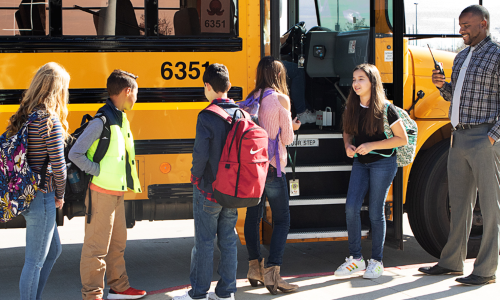A robust and comprehensive emergency communications plan protects against and diminishes threats by addressing all three elements of what the DHS Cybersecurity and Infrastructure Agency (CISA) identifies as the three security strategies schools need to deploy in emergencies: Detection, Delay and Response. Two-way radios, with their ability to instantly communicate vital information, can satisfy the requirements of each of the three strategies, which is why, according to a recent study from Pew Research, 83% of K-12 schools provide two-way radios to staff.
“Two-way radios…can operate anywhere within the signal reach without relying on a telephone network. They offer instant communications and facilitate group communications. Radios consume little power, require no service fee, and…provide a capability to send a duress call during emergencies. Radio with GPS tracking capabilities enable tracking of radio location, such as school buses, for security reasons.”
U.S. Department of Justice, Institute of Justice: Comprehensive Report on School Safety Technology
When a safety related incident occurs, details about the nature of the incident and its location can be immediately communicated to the security team by two-way radio, assuring that their response with personnel and resources will match the specific threat. The alerted security team can initiate mitigating measures like automatically activating lock down procedures or notify local law enforcement. Two-way radios become the primary means of communications during the emergency, making it easy for staff to communicate from one to many, quickly securing students and staff, and initiating evacuation procedures or other responses.
While emergency buttons, intercoms and other one-way communications technologies are valuable in communicating location, they are not a replacement for a critical exchange of information. This information goes beyond location and includes the nature of the threat and the presence of students or staff in proximity to the incident, all essential information to formulate a comprehensive response.
“In one-way communications, a message is transmitted or broadcast with no means for acknowledgement or response. With two-way communications, messages can be exchanged between two or more parties.”
U.S. Department of Justice, Institute of Justice: Comprehensive Report on School Safety Technology
Two-way radios also offer greater reliability than cell phones and other commercial or personal devices. After noticing an incident like a door that should not be open, valuable response time is lost while a school monitor finds their cell phone, scrolls through contacts, and waits for their call to go through. If the incident happens during a weather or other large-scale emergency, cell phone service can be unreliable or nonexistent due to overloading. Designed to provide strong reception and overcome dead zones, that same staff member can use their radio’s Push-To-Talk function and immediately report the open door to school security and other personnel at the same time.
Staff and security personnel patrolling school grounds are also more likely to improve a school’s ability to respond to threats if they have functioning communications equipment at their disposal. Staff patrolling school grounds must be equipped with communications devices – for example, their own radios – to effectively delay a threat.
Department of Homeland Security: Cybersecurity and Infrastructure Security Agency (CISA) K-12 School Security Guide (2022 edition).
Schools face the possibility of critical incidents that can threaten day-to-day smooth operations and the learning experience including student physical and mental health emergencies, breaches in the school’s physical barriers by intruders, school bus service interruptions, violent exchanges between students, staff and teachers and natural disasters. Two-way radios are purpose built for durability and reliability. That is why local fire, police and other critical services providers rely on them as their primary method of communications. Those professionals trust radios as the right tool to address their own unpredictable and ever-changing work challenges in protecting the public. Schools can rely on the same quality communications devices with built-to-military-specifications two-way radios.
“Emergency communication is vital to the safety and security of the staff and students in our schools. The use of dedicated emergency communications systems and technologies is essential. Normal business telephone, email and social media apps designed for routine communication are not adequate for critical communications during an emergency event.”
Partner Alliance for Safer Schools (PASS): Safety and Security Guidelines for K-12 Schools, 6th edition, 2023.
Metal detectors and surveillance cameras can send a message to students that school is a scary and dangerous place. According to a study from the Brown School at Washington University in St. Louis and published in September 2022 by the Journal of Criminal Justice, increased surveillance is having a detrimental impact on academic performance, amounting to what the study’s authors called a “safety tax”, or the price students pay for increased security and surveillance at their school.
Two-way radios can be carried unobtrusively, and digital encryption on certain models means staff and security personnel can discuss sensitive topics or emergencies without disrupting students or possible eavesdropping.
With two-way radios, “All I have to do is push the transmit button to speak to anyone at our schools or our alternative locations either privately or as a whole broadcast,” says Joye Fuston, CLA, administrative assistant, Warren County Schools. “If a crisis occurs at any of our locations, personnel can send me an emergency transmission and I can monitor the situation without the trespasser even being aware; therefore, allowing me the opportunity to contact 911.”
Campus Safety Magazine
Schools across the U.S. use KENWOOD two-way radios on campus and in their school transport vehicles for reliable, secure, and affordable communications. Schools can purchase their own system, custom designed for their facilities, or choose to use radios on a local wide-area NEXEDGE® network, operated by an authorized KENWOOD two-way radio dealer. Digital two-way radios can integrate with many existing IP network equipment or existing infrastructure. Many KENWOOD radios are compatible with existing radio brands your school may already be using. Contact us today at 1-800-950-5005 for a comprehensive review of your communications requirements.
“Everyone carries a KENWOOD two-way radio. All the building principals, the security guards, grounds, bus drivers, physical ed teachers, nurses, and everyone on each building’s Emergency Level Team”
Edwin Salas, Director of Security, West Babylon School District














